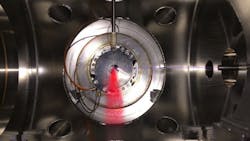Attosecond photonic technique reveals time of electron emission from atom
Using an inteferometric technique, researchers from Lund, Stockholm, and Gothenburg Unversities in Sweden have clocked how long it takes for an electron to be emitted from a neon atom via photoionization.1 The result is 20 attoseconds. The researchers' stopwatch consists of attosecond-scale laser-created light pulses. The results should help to provide new insights into some of the most fundamental processes in nature.
Although neon is a relatively simple atom with a total of ten electrons, the experiment required both extremely careful timing with a level of accuracy within one attosecond, and extremely sensitive electron detection that could distinguish between electrons whose speed differed only by around one thousandth of an attojoule (a millionth of an electron's stationary energy).
"When atoms and molecules undergo chemical reactions, the electrons are the ones that do the heavy lifting," says Marcus Isinger, a doctoral student in attophysics at Lund University. "They regroup and move to allow new bonds between molecules to be created or destroyed. Following such a process in real time is a bit of a holy grail within science. We have now come one step closer. Being able to observe how molecules exchange electrons during a chemical reaction opens the door to completely new types of studies of a number of fundamental biological and chemical processes."
Source: http://www.lunduniversity.lu.se/article/the-unbelievable-speed-of-electron-emission-from-an-atom
REFERENCE:
1. M. Isinger et al., Science (2017); doi: 10.1126/science.aao7043
About the Author
John Wallace
Senior Technical Editor (1998-2022)
John Wallace was with Laser Focus World for nearly 25 years, retiring in late June 2022. He obtained a bachelor's degree in mechanical engineering and physics at Rutgers University and a master's in optical engineering at the University of Rochester. Before becoming an editor, John worked as an engineer at RCA, Exxon, Eastman Kodak, and GCA Corporation.

